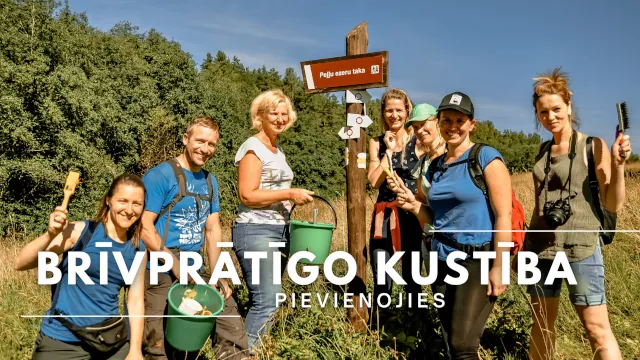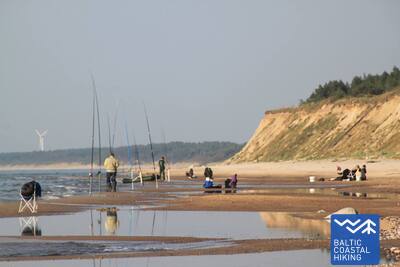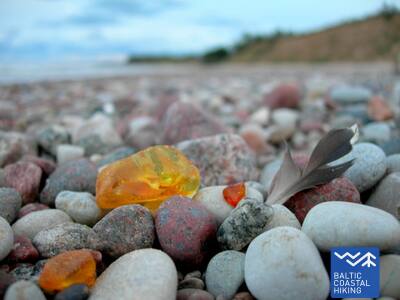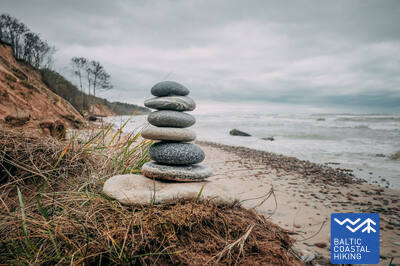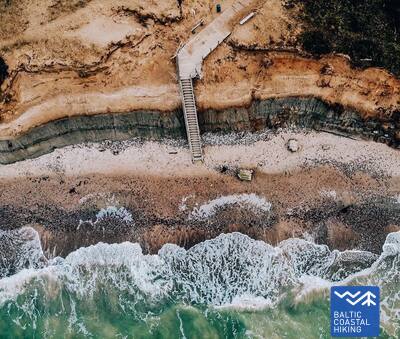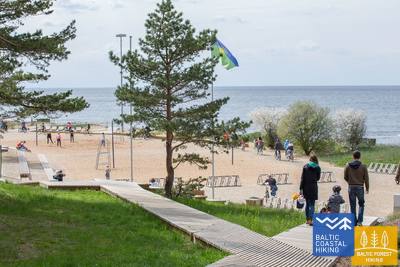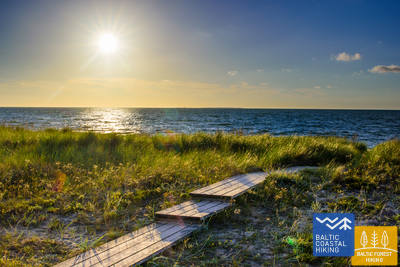Baltic Coastal Hiking trail - Nature delight
 Section 1. Nida - Pape.
Section 1. Nida - Pape.
The Pebbliest Beach In Latvia
The Latvian-Lithuanian border post is the starting point of the Baltic Coastal Hiking Route in Latvia. It goes through the Pape Nature Park crossing a wide beach bathed by the Great Sea along beautiful foredunes overgrown with sand ryegrass and marram grass. This stretch is characterized by a pebbly beach, small peat outcrops and untouched wilderness. By taking a stroll near the Pape Canal you can see a typical landscape of the Piejūra lowlands with Lake Pape hidden in the reeds. The Baltic Coastal Hiking Route winds through Pape village and returns to the beach at the Pape Lighthouse.
 Section 2. Pape - Bernāti.
Section 2. Pape - Bernāti.
The Westernmost point in Latvia
Throughout this section, the Baltic Coastal Hiking Route stretches alongside a beach. In the surroundings of Pape, the coastal side of the beach is surrounded by beautiful foredunes, while further away from the village it transforms into a washed away shore of nearly 10 km with broken pine trees lying across it. Gently sloping dunes reappear near Jūrmalciems. After passing Jūrmalciems, the wide silted beaches continue, but when coming closer to Cape Bernāti, an astounding bluff rises before your eyes which is overgrown with a pine forest and occasionally washed away.
In this section, the Jūrtaka trail continues along the coasts of the "Pape" and "Bernāti" Nature Parks, where impressive forest-covered dunes rise parallel to the sea, including some of the highest dunes on the Latvian coast. Along the shoreline, more than 10 kilometers of eroded cliffs can be seen, a result of sea erosion. The route also offers insights into other significant dune habitats, showcasing a rich diversity of plants, insects, and birds. Bernāti marks the westernmost point of Latvia.
 Section 5. Ziemupe - Pāvilosta.
Section 5. Ziemupe - Pāvilosta.
The Singing Sand and Amber
This beach is rarely visited by people and you can gather pieces of amber and little stones with fossils and hear the singing sand beneath your feet. Near Ziemupe, beautiful bluffs appear, but further on near Akmensrags and Pāvilosta there are beautiful, occasionally washed off foredunes overgrown with sand ryegrass and marram grass. In some places, you can see grey dunes. The Akmeņrags Lighthouse will serve as a good place to rest. Pāvilosta, with its provincial charm and the scent of the harbor and smoked fish will bring you back from wilderness to civilization.
The beautiful Ziemupe cliffs and the empty beach with the Akmeņrags lighthouse are among the most secluded spots on the Latvian coast. Here, you can explore dune habitats with their characteristic plants and insects. Akmeņrags is an ideal location for birdwatching. Part of the area is within the Ziemupe Nature Reserve. On the shore, you might find washed-up amber and fossils.
 Section 6. Pāvilosta - Jūrkalne.
Section 6. Pāvilosta - Jūrkalne.
The Most Outstanding Bluffs Around The Baltic Sea
To the northeast of Pāvilosta, there are excellent views of the grey dunes, while only a couple of kilometers further you can see the beginning of one of the most beautiful sections the Baltic Coastal Hiking Route with outstanding bluffs continuing for more than 20 km. The most interesting bluff scenery is located near Strante and Ulmale villages and the estuary of the Rīva River. In many places, orchids bloom on the lower part of coastal landslides in summer. In Jūrkalne and in its surroundings, you can see “two sunsets”: the first one from the beach and the second one from the top of the bluff a couple of moments later.
 Section 7. Jūrkalne - Sārnate.
Section 7. Jūrkalne - Sārnate.
The Place Where People Crossed The Baltic Sea In Boats
The astounding bluffs of the Baltic Sea continue in this section of the Baltic Coastal Hiking Route. Near Ošvalki village, it descends turning into a steeper foredune covered in thick osier wreaths, while opposite to Sārnate village distinct bluffs reappear. Here in this comparatively short walking section you can see several impressive sceneries.
 Section 8. Sārnate - Užava.
Section 8. Sārnate - Užava.
The Most Beautiful Scenery Of The Latvian Seacoast
Near Sārnate, you can still see the bluffs of the Baltic Sea, which slowly become lower towards the North and is replaced by a washed away dam of foredunes. Between Vendzavas village and the Užava Lighthouse, you can see coastal sceneries that are quite unusual for Latvia and that remind one of sandy and rocky deserts with sparse vegetation: it used to be a firing ground for the Soviet army. In this place and in the territories of former firing grounds located beyond the Užava Lighthouse, there are now grey foredunes. Getting closer to the estuary of the Užava River, the beach becomes wider and the dunes – lower. The most beautiful scenery of the Baltic Coastal Hiking Route can be seen from the top of the romantic Užava Lighthouse.
A remote coastal stretch featuring exceptional grey dune and rugged coastal habitats within the "Užava" Nature Reserve and beyond. From the Užava Lighthouse, one can enjoy one of the most beautiful views of the Baltic Sea. The coastline still has some cliffs in places. It is an excellent location for photographing plants, insects, and other natural elements.
 Section 11. Staldzene - Oviši.
Section 11. Staldzene - Oviši.
Destination – Cape Oviši
When climbing down to the beach of Staldzene, you can already see a bluff that is a couple of meters high and occasionally barren and that gradually becomes higher and higher (the peak point is Kokkalns, at 29 m). 3-4 km to the SE of Staldzene, a narrow section of beach with a bluff has formed, bathed by the waves during strong winds. After passing Liepene, the washed away coastline is slowly becoming lower and beyond Jaunupe, all the way to Cape Oviši, wide beaches have formed with the widest area situated at the tip of Cape Oviši.
The Staldzenes cliffs are fascinating not only from a geological perspective but are also scenically stunning and impressively large. Near Oviši, expansive sandy beaches are forming. This stretch is ideal for solitary nature enjoyment, exploring coastal dune habitats and their inhabitants, and for photography.
 Section 12. Oviši village - Miķeļtornis village.
Section 12. Oviši village - Miķeļtornis village.
Between Oviši Lighthouse and Miķeļbāka Lighthouse
The Baltic Coastal Hiking Route leads through the Oviši Nature reserve where the typical coastal scenery is formed by wide sandy beaches and dunes. Here, the materials naturally found on the beach, the pebbles and sand, create big natural mosaics. In Lūžņa village, military objects from different periods are of interest to visitors, yet near the estuary of the Lūžupe River the seasonal closure must be observed in order to protect the nesting birds: it is prohibited to go there from 01.04. to 01.08. You must go around this place by following the indications marked in the Baltic Coastal Hiking Route. The destination of the itinerary, the Miķeļbāka Lighthouse, can be seen from afar.
 Section 13. Miķeļtornis village – Sīkrags village.
Section 13. Miķeļtornis village – Sīkrags village.
Destination – Slītere National Park
Starting from Miķeļtornis up to the turn towards the cable bridge over the Irbe River, a wide beach with low, sparse foredunes lays before your eyes. For ~ 4,5 km, the itinerary goes around the estuary of the Irbe River where a seasonal closure is in force in order to protect nesting birds and where it is forbidden to enter from 01.04. to 1.08. By taking a detour, the Baltic Coastal Hiking Route passes through a beautiful pine forest with high dunes the slopes of which are rich with mushrooms and berries. After passing the estuary of the Irbe River and as far as Sīkrags village, you will find a stretch of wide sandy beach and ~ 1 km before reaching Sīkrags you will see the Ķikans brook crossing the beach and marking the border of the Slītere National Park. Also in the territory of Ķikana estuary from 1.04. until 1.08. ~ 600 m long beach and dune section is closed to visitors. During this period, people can cross it along the very shore of the sea without undue delay and keep the dog on a short leash.
The Jūrtaka trail section initially winds through the "Oviši" Nature Reserve and ends in the Slītere National Park. The forests between the new Irbe Bridge and Jaunciems are ideal for berry-picking, mushroom foraging, coastal nature exploration, and photography. This area marks the beginning of the so-called Livonian Coast, which extends to Ģipka.
 Section 15. Saunags village – Kolka.
Section 15. Saunags village – Kolka.
The Heart Of Europe: Cape Kolka
The Baltic Coastal Hiking Route winds through small country and forest roads from Saunags village to Vaide village where it returns to the seacoast again. Wide sandy beaches stretch up to Cape Kolka turning into low sparse foredunes; wooded seaside dunes continue behind them. For around 2 km, there are washed away dunes followed by the Dumbrkalni Hills. Cape Kolka, the point where the Great Sea meets the Little Sea, is one of the most popular bird-watching sites on the Baltic seacoast.
The Jūrtaka trail section traverses both coastal pine forests and sandy beaches. Kolkasrags is one of the most popular attractions in Northern Kurzeme, where the Baltic Sea meets the Gulf of Riga. It is a favored spot for birdwatching and storm watching. On the pine trail, you can explore coastal habitats and their inhabitants.
 Section 16. Kolka - Ģipka.
Section 16. Kolka - Ģipka.
Along The “Closed Coast”
At Cape Kolka, when turning towards the Gulf, you can clearly see the difference between the “Great Sea” and the “Little Sea”. The first 10 km of the Baltic Coastal Hiking Route lead through the coastal area of the Slītere National Park: first, past pine trees that are washed into the sea, past the building of a former fishing kolkhoz, a ship berth and Ēvaži Bluff which is surrounded by an unusually narrow sandy beach with overhanging black alders. The next section of the trail leading to Ģipka also has a narrow sandy beach with pools created by the rich springfens and the mouths of small streams that are shallow in summer. During Soviet times, the seacoast of the Slītere National Park was a closed territory for two reasons: it was a frontier zone and a nature reserve.
A scenically beautiful and diverse coastal stretch features wooded dunes, picturesque foredunes, the Ēvaži cliffs (with a nature trail and observation point), and small streams flowing into the Gulf of Riga. In some areas, the narrow shoreline includes small ponds, which are important habitats for amphibians, insects, plants, and birds.
 Section 17. Ģipka - Kaltene.
Section 17. Ģipka - Kaltene.
The Rocky Beach of Kurzeme
A sandy beach that is not too wide and has beautiful dunes and coastal pine forests stretches from Ģipka to Roja, but before reaching Roja it is overgrown with reeds. Conversely, the section between Roja and the Kaltene Church is one of the most extraordinary parts of the seashore of Latvia, where the coast is notched by small capes and coves with a very narrow beach. All over the coast, there are piles of boulders of different sizes with the green foliage of black alders hanging over them. In some places, the large gnarled root systems of the trees washed ashore rise before your eyes. In some places, an unpaved road goes right along the coast and a lot of former fishermen homesteads are aligned next to it.
In terms of biodiversity, the Jūrtaka trail section between Ģipka and Rojas features primarily sandy beaches with dune habitats. Beyond Rojas, the coast transitions to rocky stretches, marked by numerous land formations and covered with alder groves. This area is well-suited for exploring and observing plants, insects, and birds.
 Section 18. Kaltene - Mērsrags.
Section 18. Kaltene - Mērsrags.
The Multifarious Coast
A truly multifaceted section of the Baltic Coastal Hiking Route in terms of nature, cultural history and scenery. Near Kaltene village, the seashore is speckled with small coves with rocky beaches followed by a thickly overgrown coast where a narrow trail winds its way through reeds and lush vegetation. Further on, the seacoast covered in stones is only a couple of meters wide, in some places it has layers of clay, fields of reeds, in other places, it is carpeted with the algae washed ashore. Sandy beaches with shoals in the sea reappear between Valgalciems village and Mērsrags village. After passing Mērsrags village, the itinerary continues on a road, but when you reach the Lutheran church it turns towards the sea and goes through the coastal meadows as far as the center of Mērsrags village.
This coastal section is relatively unusual for Latvia. Around the Kaltene area, the coastline is dominated by rocky shores richly covered with vegetation. Moving towards Mērsrags, sandy beaches gradually appear, and around Mērsrags, the coast is a mix of sandy and rocky areas. This section is ideal for observing plants and birds, and for exploring various coastal habitats.
 Section 19. Mērsrags - Engure.
Section 19. Mērsrags - Engure.
In the Engure Nature Park
A forest trail surrounded by pine trees leads you from the center of the village to the beach. Next, the Baltic Coastal Hiking Route meanders between a rocky seacoast richly overgrown with reeds and other grasses on one side and wooded seaside dunes on the other side. In some places, the beach is paved with small round stones, in other places you can see grey dunes with a rich variety of plants. Near Bērzciems village, there are large coastal meadows with shoals appearing far away in the sea that are suited for birdwatching. Overgrown seacoast continues up to Abragciems village, while from Abragciems to Engure there is a beach.
This Jūrtaka trail section is diverse in terms of landscape, geology, and habitat types, featuring various kinds of shorelines including sandy, rocky, and overgrown areas. Around Bērzciems, the sea forms shoals with seasonal lagoons, making it an excellent spot for birdwatching. The area is part of the "Engure Lake" Nature Park.
 Section 26. Carnikava - Saulkrasti.
Section 26. Carnikava - Saulkrasti.
The Sunset Trail With Romantic Sunset Vistas
Initially, the itinerary leads you through the Gauja River levees in Gauja village reaching the estuary of the Gauja River, which is a good place for bird watching. The hike continues along a sandy beach up to the estuary of the Inčupe River, before which you have to turn inland to get to a bridge and to cover the next couple of kilometers across the wooded dune tops of the Sunset Trail with a view of the beach. After crossing the Pēterupe River (cable bridge), the Baltic Coastal Hiking Route continues along the beach and reaches the Sea Park in Saulkrasti.
 Section 28. Lauči - Tūja.
Section 28. Lauči - Tūja.
The Bygone Times Of Sailing Ships
This section of the seacoast of Vidzeme is of outstanding scenic beauty with a lot of rocky capes and boulders in the sea alternating with small, sandy coves where the small streams and rivulets, which dry out in summer, flow into. Occasionally, the beach is completely covered with the gray backs of stones. In some places, small patches of reeds appear, while near Tūja you will see the first sandstone outcrops.
 Section 29. Tūja - Svētciems.
Section 29. Tūja - Svētciems.
The Rocky Beach of Vidzeme
One of the most beautiful sections of the Baltic Coastal Hiking Route, which begins by crossing the Zaķupīte River. Up to the Ķurmrags Lighthouse, there are mostly sandy beaches with small sections of stones. Further on, the Rocky Seashore of Vidzeme starts: capes alternate with small coves, while 4 m high sandstone outcrops emerge on the coast. Sandy beaches continue to prevail after passing Cape Meleki, while before the mouth of the Svētupe River the beach is thickly overgrown and reedy, so it must be bypassed via a forest trail.
This section of the rocky Vidzeme coast features a highly diverse shoreline with small land formations, coves, rocky beaches, and Devonian period outcrops—results of sea erosion. It is part of the "Vidzemes Rocky Seashore" Nature Reserve. This area is ideal for nature observation, mushroom and berry picking, photography, and filming, especially during stormy weather. Near the Svētupe River mouth, the coast starts with a richly vegetated overgrown shoreline. It is also a great spot for birdwatching. The Jūrtaka trail section is included in the Northern Vidzeme Biosphere Reserve.
 Section 30. Svētciems - Ainaži.
Section 30. Svētciems - Ainaži.
The Lamprey Kingdom
The beach between Svētciems village and Salacgrīva is thickly overgrown, so the Baltic Coastal Hiking Route continues on a forest trail meandering among the dunes. To get from Salacgrīva to Kuiviži, you can take the sandy beach or forest trails. From Kuiviži to the Vēverupe River, you have to bypass the Randu Meadows via a forest road located on the east side of the A1 road. After passing the Vēverupe River, the Baltic Coastal Hiking Route returns to a thickly overgrown beach and then leaves it next to the estuary of the Blusupīte River to reach Ainaži Pier by going along Kāpu and Valdemāra iela. You have covered ~ 580 km in Latvia and reached the state border.
This section features a coast overgrown with dense vegetation, so the Jūrtaka trail primarily follows small forest paths, occasionally winding along the shoreline. Between Kuivieži and Ainaži, you'll find the Randu Meadows Nature Reserve, one of the richest areas for biodiversity on Latvia’s coast, notable for its plants and birds. It is an excellent spot for birdwatching, with a nature trail and a birdwatching tower available. Between Svētciems and Salacgrīva, the area is good for berry-picking and mushroom foraging. Additionally, there is a lamprey fishing trail built on the Svētupe River. This section of the Jūrtaka trail is part of the Northern Vidzeme Biosphere Reserve.
 Section 31. Ikla - Kabli.
Section 31. Ikla - Kabli.
Along the Paths of the Historic Resort
Ikla is the start of the Baltic Coastal Hiking Route in Estonia. In the section connecting Ikla and Treimani, the route leads you along the old Pärnu–Riga road as meadows and reeds stretch across the seashore. After passing Treimani, the trail turns towards the sea and the next 2,8 km are covered across a narrow, sandy or rocky and occasionally thickly overgrown beach. After bypassing the Orajõe Brook, next to the parking lot the trail returns to the beach followed by a hike of ~ 4 km to Hotel Lepanina. There you will have to return to the old Pärnu–Riga road leading you to Kabli. Several good birdwatching sites are located on the itinerary. The coastal area up to Pärnu is a popular relaxation and swimming area.
 Section 32. Kabli - Häädemeeste.
Section 32. Kabli - Häädemeeste.
Birds, Dunes and Forests
This itinerary is particularly recommended for birdwatchers. To cover the section of the Baltic Coastal Hiking Route connecting Kabli and the South of Häädemeeste, you will have to take the old Pärnu–Riga road because reedy meadows and lagoons stretch across the seashore. Before reaching Häädemeeste, the Baltic Coastal Hiking Route branches off from the road and meanders through Jaagupi Nature reserve (going around the east side of the village) running up the backs of high dunes and scooting down to the deep troughs between the dunes covered with a sparse pine forest. Here you will find good places for picking berries and mushrooms.
 Section 33. Häädemeeste - Uulu.
Section 33. Häädemeeste - Uulu.
Through Forests and Bogs
This section of the Baltic Coastal Hiking Route is suitable to hardy hikers who like to travel across uninhabited places. The itinerary leads you through Luitemaa Nature reserve with beautiful conifer forests and inland dunes covered with white carpets of reindeer lichen. In the summer and autumn, you will find suitable places for observing birds and animals, as well as picking mushrooms and berries. The Baltic Coastal Hiking Route winds along the west edge of Maarjapeakse Bog and after running through a mosaic of forests and clearings it leads you to Lepaküla and Uulu villages.
The Coastal section leads through the Luitemaa Nature Reserve with beautiful coniferous forests on inland dunes, covered with white carpets of reindeer lichen. In summers and autumns, this area is suitable for bird and animal watching, as well as mushroom and berry picking. A bog boardwalk has been established in Soometsa.
 Section 36. Liu - Munalaid.
Section 36. Liu - Munalaid.
Bays, islands and birds
The itinerary is suitable for birdwatching. The Baltic Coastal Hiking Route takes roads and trails because coastal meadows, reeds, shallow and overgrown coves cover the seashore. After passing Liu Port, the Baltic Coastal Hiking Route changes its direction several times as the coastline is rugged and difficult to access, so the itinerary must be adapted. The best sightseeing and birdwatching areas are located near Kavaru village, in the surroundings of the Port of Peerni and near Munalaid Harbour where you can see panoramic views of Pärnu Bay and Kihnu Strait with their islands (Sorgu saar, Manilaid, Kihnu) and coastal meadows with cattle grazing there.
The route is suitable for bird watching. From Coastal trail, you can see coastal meadows, reed beds, shallow and overgrown bays. The best viewing and bird-watching spots are near Kavaru village, around Peerni harbor, and near Munalaid harbor, where you can see the wide views of Pärnu Bay and the Kihnu Strait with islands, as well as coastal meadows where livestock graze.
 Section 39. Matsi - Varbla.
Section 39. Matsi - Varbla.
Beaches and Forests
Matsi beach is one of the rare sandy beaches in the subsequent section of the trail leading to Haapsalu. The Baltic Coastal Hiking Route takes you on a small stroll through Kulli village and for the next 5 km leads you along small trails surrounded by wide forests and dunes. In autumn, their surroundings are rich in berries and mushrooms. After bypassing Uue-Varbla Manor, the trail reaches Varbla village.
 Section 40. Varbla - Pivarootsi.
Section 40. Varbla - Pivarootsi.
Coastal Manors
The Baltic Coastal Hiking Route goes along coastal roads, yet the sea is only visible in two places as its shore is dappled with shallow coves, small islets, damp coastal meadows, reeds, lagoons, bogs and lakes that have separated from the sea. In the surroundings of Varbla-Allika, you will see farmland scenery, while the Allika-Tamba section mostly goes through beautiful forests. After bypassing the Paatsalu and Illuste Manors, the Baltic Coastal Hiking Route continues on a road crossing wetlands in Nehatu Nature reserve and near Muriste village it meanders along a road, on the side of which there is an impressive rock fence. Before reaching Pivarootsi Manor, vast pastures and a view of the bay appear in sight.
 Section 41. Pivarootsi - Virtsu.
Section 41. Pivarootsi - Virtsu.
The Gate to the Estonian Islands
In this section, an ~ 3,7 km stretch of the Baltic Coastal Hiking Route goes along the former Virtsu-Rapla narrow-gauge railway. The most fascinating place in this section is the Puhtulaiu Peninsula: it is an island that has nowadays merged with the continent. It is covered by a broad-leaved forest with interesting plant and mushroom species, giant trees and memorial sites in honour of important people. Ferries go from the Port of Virtsu to Muhu Island which is connected to Saaremaa Island via a dam.
The most interesting place in this section of the Jūrtaka trail is the Puhtulaiu Peninsula (nature reserve) – an island that has now connected with the mainland. It is covered with broadleaf forest featuring interesting plant and mushroom species, ancient trees, significant memorial sites, a nature trail, a bird-watching tower, and more. Also noteworthy is the former narrow-gauge railway embankment that crosses a shallow bay, which is a suitable spot for bird watching.
 Section 42. Virtsu - Kuke.
Section 42. Virtsu - Kuke.
Through Orchid and Juniper Fields
The Baltic Coastal Hiking Route snakes through Virtsu village after which it goes along a motorway for 3 km and then it takes a 90 degree turn towards the northwest, meandering through a wind farm and a former Soviet military airfield, in the surroundings of which orchids bloom beautifully during the summertime. Next, you will see the Suur Väin Strait and beautiful juniper fields. Before reaching the Jõeoja Brook, for ~ 1 km the road goes along the upper part of the ancient seacoast.
 Section 43. Kuke - Meelva.
Section 43. Kuke - Meelva.
Along the Islands of the Baltic Ice Lake
The Baltic Coastal Hiking Route goes along small country roads where individual farmsteads and cultivated fields appear in sight. When approaching Matsalu Bay, you will see wetlands: overgrown lakes that have once separated from the sea as bays and coastal meadows ruined by grazing cattle. Near Mõisaküla (the beginning of Matsalu National Park) and Salevere villages, distinct hillocks appear that used to be islands in the Baltic Ice Lake more than 10 000 years ago.
 Section 44. Meelva - Penijõe.
Section 44. Meelva - Penijõe.
Following the Trail of the Livonian Chronicle of Henry
For this day, the start and end point for the current section of the Baltic Coastal Hiking Route are located in Matsalu National Park, but the major part of it lies outside the park’s territory. Travellers will have their attention captured by the small villages and country roads with beautiful individual farmsteads and rural landscapes with cows and sheep grazing in the grass, as well as Lihula, the first see of the Bishopric of Saare-Lääne (Ösel–Wiek), which is indirectly mentioned in the Livonian Chronicle of Henry in relation to the events of 1211 when Abbot Theoderich of the Daugavgrīva (near Riga) monastery was ordained as the first Bishop of Estonia.
 Section 46. Haeska - Puise.
Section 46. Haeska - Puise.
Observing Birds and Nature in Matsalu National Park
One of the most beautiful sections of the Baltic Coastal Hiking Route in Matsalu National Park, which leads through the agricultural lands and coastal meadows located near Matsalu Bay, where thousands of migrating cranes and geese gather in autumn. There are excellent birdwatching sites with towers near Haeska village (coastal meadows, shallow coves, small islets, cattle pastures) and at Cape Puise (coastal meadows with pastures, shoals). The most panoramic views of the sea and strings of islands can be seen in the surroundings of Põgari-Sassi and Puise nina.
The Coastal trail section includes several places along the seashore where you can see a shallow bay with stones, small islands, and coastal meadows, which are good bird-watching spots. The walk can include the national park's trail between Kiideva and Puise nina. Bird-watching towers and platforms have been established.
 Section 51. Riguldi - Dirhami.
Section 51. Riguldi - Dirhami.
A Place Marked by Meteorites
With the exception of the first 3 km, the itinerary goes along the seashore. It is mainly a sandy beach with beautiful foredunes, grey dunes and sea boulders. The beach may be covered in algae that has been washed ashore and it is occasionally overgrown with dense vegetation. Opposite Rooslepa village and in other places in the sea and on the coast, there are badly weathered stones or the so-called breccias that have melted and weathered as a result of an ancient meteorite explosion. At the destination of the itinerary, you can spend some time in a pub and from its terrace you will have a beautiful view of the sea and the port.
Various dune habitats (white dunes, grey dunes) can be explored, along with different types of beaches (sandy, overgrown), and beautiful coastal pine forests with small paths. The route is suitable for discovering natural diversity, plants, birds, and geology. On the shore and in the sea, you can see breccias - rocks fused and decayed as a result of an ancient meteorite explosion. The coastal forests are suitable for mushroom and berry picking.
 Section 52. Dirhami - Nõva.
Section 52. Dirhami - Nõva.
The Harsh Northern Nature
An exceptionally multifaceted section of the Baltic Coastal Hiking Route in terms of landscapes, where you can already get an insight of the nature characteristic to the north coast of Estonia. The itinerary leads you along the seacoast for almost its entire length, where you will find beautiful sandy beaches near coves, beaches covered in boulders at capes, while dolomite layers uncover themselves in the northern part of Cape Põõsaspea (an excellent birdwatching site). The Baltic Coastal Hiking Route goes through Nõva Nature reserve where you will have exceptional views of the white and grey dunes. The beaches are popular for fishing and kite-boarding.
Various dune habitats (white dunes, grey dunes) can be explored, along with different types of beaches (sandy, overgrown, rocky, covered with dolomite), and beautiful coastal forests with small paths. The route is suitable for discovering natural diversity (rest areas, viewing platforms, nature trails), plants, birds (Põõsaspea neem - an excellent bird-watching spot), and geology. The coastal forests are suitable for mushroom and berry picking.
 Section 53. Nõva - Vihterpalu.
Section 53. Nõva - Vihterpalu.
Along the Gulf of Finland
Starting from Rannaküla and after bypassing the wetland, the Baltic Coastal Hiking Route crosses the small Nõva River and leads you to the beach at Keibu Bay (overgrown at the beginning) where a sandy seashore with dunes stretches before your eyes. Near Keibu Brook, it turns inland where its continuation coincides with the trail marked by the Estonian State Forest Management Centre: Peraküla – Aegviidu – Ähijärve. The trail snakes through the small Keibu village and emerges at the beach opposite Alliklepa village with beautiful juniper fields. Further on, the trail leads you between the sea and two small lakes that used to be coves. Opposite them, you will see dolomite outcrops in the seabed. Next, the trail takes a small road along the seacoast (you can see the Pakri Islands) until reaching Vintse village and then it turns towards Vihterpalu.
Various dune habitats (white dunes, grey dunes) can be explored, along with different types of beaches (sandy, overgrown, rocky, covered with pebbles and dolomite), and beautiful coastal forests with small paths and juniper fields. The route is suitable for discovering natural diversity, plants, birds, and geology. The coastal forests are suitable for mushroom and berry picking.
 Section 56. Paldiski - Kersalu.
Section 56. Paldiski - Kersalu.
Cliffs, a Lighthouse and Military Heritage
The Baltic Coastal Hiking Route leads around the Pakri Peninsula, from whose rocky shores you will discover the most beautiful coastal landscapes in northwest Estonia. It goes through the centre of Paldiski and, after having reached the fortress bastions of Peter I, it turns towards the Pakri Lighthouse going across the upper part of the impressive Pakri Cliffs. Further on up to Kersalu, there are both ups in the shape of rocks and downs where the Baltic Coastal Hiking Route meanders along a sandy and rocky seacoast and a beautiful pine forest. Pakri Cliffs are alluring both in cold winters, when impressive icefalls are formed here, and during the time of colourful leaves in autumn.
This section features the most impressive cliffs and steep shores of the Coastal trail (in all Baltic countries) that surround the Pakri Peninsula. They offer fantastic views in different seasons. It is a suitable place for geotourism, exploring various geological objects such as outcrops, layers from different geological periods, boulders, and more.
 Section 58. Laulasmaa - Vääna-Jõesuu.
Section 58. Laulasmaa - Vääna-Jõesuu.
The Most Beautiful Waterfall in Estonia
A multifaceted section of the Baltic Coastal Hiking Route in terms of landscape that is suitable for hardy hikers. There are both rocky and sandy beaches and good swimming areas, fascinating coastal pine forests, the astounding Türisalu Cliff wall and giant sea boulders. By taking the trails of the vast Keila forest park, you can go to the Keila waterfall, near which some fragments of the popular Latvian feature film Vella kalpi (Devil’s servants) were shot, and you can also get to know the exhibition dedicated to the life of coastal fishermen in Lohusalu village.
 Section 59. Vääna - Jõesuu - Tabasalu.
Section 59. Vääna - Jõesuu - Tabasalu.
The Fabled Suurupi Peninsula
One of the most complicated sections of the Baltic Coastal Hiking Route, suitable only for experienced hikers. The itinerary circles the Suurupi Peninsula where the dense forests conceal the military heritage of different eras. The Baltic Coastal Hiking Route meanders through overgrown and rocky seacoasts, birch groves, along former pioneer camps and sand-stone cliffs protecting coves with sharp capes. In some places, the sea uncovers its dolomite base, while in other places you can see boulder “islands”. At the end of the itinerary, one of the most astounding outcrops of the Estonian littoral rises before your eyes – the Rannamõisa Cliffs, which gives views of Kakumäe Bay and Peninsula and the towers of Tallinn’s Old Town.
Although close to Tallinn, this secluded section of the Coastal trail features a uniquely indented coastline with sandstone outcrops (Suurupi cliff) and the impressive Rannameisa cliffs. Interesting boulder formations can be found along the shore. It is a suitable place for mushroom and berry picking, as well as bird and plant watching.
 Section 65. Pervalka – Juodkrantė.
Section 65. Pervalka – Juodkrantė.
Along the most majestic sand dunes in Northern Europe
Having departed Pervalka, the Baltic Coastal Hiking Route follows a pedestrian path to cross the Curonian Spit in an east–western direction, arriving at the coast of the Baltic Sea. The next section of 13 km leads along a beautiful, sandy beach protected by high and steep sand dunes on the east. It is called the protective dune ridge and it has been man-made in order to protect the inland from the movement of sand. Entering Juodkrantė, the Baltic Coastal Hiking Route turns eastward and crosses the Curonian Spit once again over wooded and steep dunes, to reach the Curonian Lagoon coast. The Baltic Coastal Hiking Route briefly coincides with the Hill of Witches trail. It then follows the Juodkrantė beachside walkway to the port. This section leads through the Curonian Spit National Park.
The section of the Curonian Spit (Kuršių nerija) where you can explore both open, sandy dunes and their formations on the Naglių rezervato gamtos takas, as well as already forested dunes and their ridges on Witch Hill (Raganų kalnas). The colony of cormorants and herons is a suitable bird-watching spot. Amber can be found on the seashore. This section is part of the Curonian Spit (Kuršių nerijos) National Park.
 Section 66. Juodkrantė – Klaipėda.
Section 66. Juodkrantė – Klaipėda.
Klaipėda — Lithuania’s gate to the sea
Having left the Juodkrantė beachside walkway, the Baltic Coastal Hiking Route crosses the Curonian Spit in a southeast–northwest direction leading along single-track forest trails that wind through the steep, pine-covered dunes until it eventually comes back out onto the coast of the Baltic Sea. For the next 9 km, the Baltic Coastal Hiking Route follows the coastline along sandy beaches. The steep foredune on the eastern side protects the inland from the moving sand. After Alksnynė village (not seen from the beach), the Baltic Coastal Hiking Route turns eastward, crossing a hillock covered in Pinus mugo pines and a World War II German army base, eventually approaching the coast of the Curonian Lagoon. Then the trail winds across the ridges of pine-covered dunes, providing regular views of Klaipėda Port. The route between the New and Old Ferry Port first follows a single-track path, and later a beachside walkway. Having crossed the Curonian Lagoon from the Old Ferry Port, the Baltic Coastal Hiking Route arrives in the center of Klaipėda where it follows Danės Street to the Birža Bridge. The section until Smiltynė leads through the Curonian Spit National Park.
In this section, various Curonian Spit ( Kuršių nerija ) habitats can be explored - sandy beach, foredunes, forested dunes (with common pine and mountain pine), burnt areas, and more. It is a suitable place for bird-watching, mushroom picking, and berry picking. This section is part of the Curonian Spit (Kuršių nerija) National Park.
 Section 69. Rusnė Island.
Section 69. Rusnė Island.
Rusnė Island — excellent location for wildlife observation
The Baltic Coastal Hiking Route starts in the village of Rusnė on Rusnė Island. The trail leads through Neringos Street and K. Jukštaičio Street out into Rusnė Village beachside walkway extending along the Pakalnė River — one of the biggest distributaries of the Nemunas Delta. The Baltic Coastal Hiking Route further leads through the small port of Rusnė snaking through the polder dikes of Rusnė over to the village of Pakalnė, providing wonderful views along the way of the colourful architecture of the island and the willow trees overhanging the Pakalnė waters. After the Village of Pakalnė, up until Uostadvaris Lighthouse, the route mostly follows the Rusnė polder dikes, which enclose and interweave the low island (there is a spot on the island that is below sea level) to protect it from flooding. From the lighthouse to the village of Rusnė, the Baltic Coastal Hiking Route goes along the side of a paved road (except in the village of Uostadvaris, where the trail follows the polder dike on the bank of the Atmata River). In the village of Rusnė, the trail follows Kuršmarių Street and Taikos Street back to its starting point. Rusnė Island is located inside the Nemunas Delta Regional Park. The polder dikes are excellent for observing wildlife in the low flatlands — roe deer, elk and birds during spring and autumn migration can be seen here.
 Section 71. Šilutė – Ventė.
Section 71. Šilutė – Ventė.
Through Nemunas Delta Regional Park
Along Klaipėdos Street and Aukštumalės Street, the Baltic Coastal Hiking Route leaves the town of Šilutė in the direction of Kintai (Road No. 4217), briefly following the top of the polder dike (offering a good view of the Nemunas Delta lowland which floods in springtime), it then snakes along a rural road and returns back on to Aukštmalės Street (Road No. 4217). After less than 6 km, at the intersection in the Village of Rūgailiai the Baltic Coastal Hiking Route loops leftward towards Minija, and after 1.5 km it bears right, returning back on to the Šilutė–Kintai road. The Baltic Coastal Hiking Route crosses the Minija River and the Kintai Carp Lakes over a high and long bridge. From here, you will have one of the most spectacular views of the Lithuanian coastline with an expansive panorama of lowlands and waters. Before reaching the Village of Povilai, the trail turns left, leading through agricultural land for about 5 km where birds can be observed during migration season. Then the Baltic Coastal Hiking Route turns on to a beachside road (Marių Street, Road No. 2201) which leads to the Ventė Cape 5 km away. This scenic section of the route offers expansive views of the Curonian Spit across the Curonian Lagoon (the width of the gulf here is 8–9 km). Hikers can also enjoy the former fishing villages with their colourful, decorated buildings. This section of the trail is part of the Nemunas Delta Regional Park.
The section of the Coastal trail between Kintai Pond and Ventė Cape is a popular spot for bird-watching and photography, especially during migration periods. An ornithological station is located at Ventė Cape. The open coastal plain landscape is suitable for observing and photographing wildlife. This section is part of the Nemunas Delta Regional Park.











